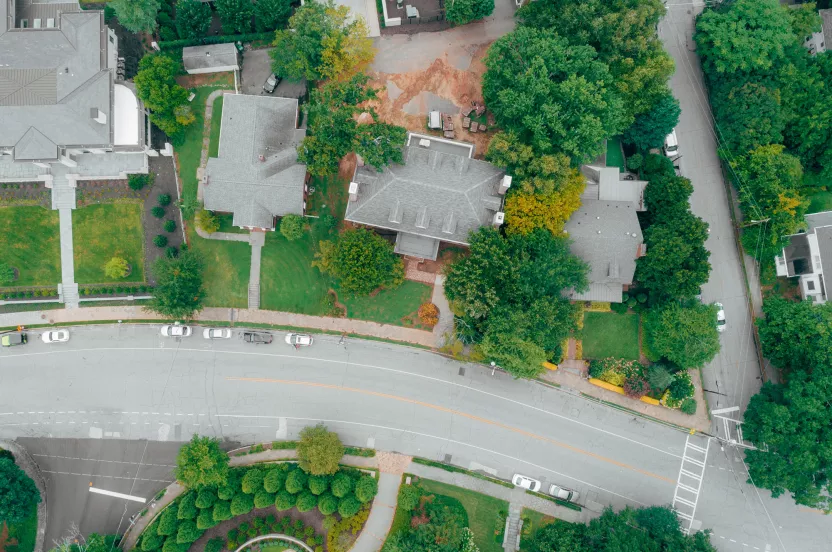Give before midnight on July 31 to double your impact where trees need us most. CHOOSE A PROJECT
A Tree Can Be An Equalizer
How The Arbor Day Foundation Approaches Tree Planting In Underserved Communities.
July 14, 2023

One might assume everybody has access to trees, greenspace, and nature regardless of race, color, or creed.
But dig a little closer and another story emerges. Pull up any satellite map of most urban areas of the United States and it will yield a patchwork of green hues prominent in some locations, hard to find in others.
Too often, it’s people of color living in these neighborhoods with less access to greenspaces and nature. This nature disparity can have further dire consequences beyond access to nature’s benefits. Climate change, for example, is creating worsening challenges for everyone, yet its impacts are felt disproportionately by those least equipped to face them.
Nature-poor neighborhoods and climate inequities are nothing new. The disparity goes back generations as historic discrimination in urban areas has negatively impacted the social, economic, and wellness outcomes of their residents.
Community leaders and policymakers are putting more effort and resources towards correcting environmental injustices. Included in these discussions are how a tree can be a difference-maker, helping to alleviate the environmental injustices overlooked for far too long.
Our unmatched network of partners is helping to meet this moment and work with neighborhoods in need using a simple solution from nature itself: Trees.
The power of trees in neighborhoods
Trees do so much for the people nearby. Living in proximity to trees improves physical health and mental well-being. Numerous studies show trees make people more physically active and even prevent respiratory ailments like asthma. They may also make people happier and less depressed. These natural landmarks give personality to neighborhoods, act as gathering spaces to strengthen connections among neighbors and reduce crime, littering, and vandalism.
Trees improve the lives of the people they surround and help turn a collection of residences into a connected, more vibrant neighborhood. And too many areas, for far too long, have gone without the benefits of trees.
How trees play a role in environmental justice
Environmental justice is the fair and meaningful involvement of all people with respect to the development and implementation of environmental laws, regulations, and policies that impact lives. It can help counteract injustices that are all too familiar in underserved communities, including polluted local water sources or positioning neighborhoods near hazardous waste sites.
We believe a tree can be a solution for some of the environmental challenges historically disadvantaged communities face today. In the context of tree planting, pursuing environmental justice means it's no longer enough for tree planting organizations to simply select low-and moderate-income neighborhoods when determining where trees are needed most. It is necessary to do more while letting the community leaders themselves lead the way.
Aligning tree plantings with tenets of environmental justice
To ensure tree planting efforts are implemented equitably and aligned with the tenets of environmental justice, it’s imperative to follow a few best practices:
- Leverage multiple data points beyond income level when choosing where to plant, taking other key socio-economic, environmental, and historical factors into consideration.
- Partner with local organizations made up of neighborhood residents to ensure tree plantings take place when, where, and how the immediate community members prefer.
- Consult with community leaders to determine what type of project (planting, distribution, community engagement, etc.) will best serve the area.
Arbor Day Foundation’s approach to environmental justice tree plantings
At the Arbor Day Foundation, environmental justice tree-planting projects start with data and information from cities and technology partners to locate and prioritize low-canopy neighborhoods.
This data-driven approach is important to maximize the impact of each tree planted in neighborhoods of greatest need, but it is only the first step.
The Arbor Day Foundation and its unmatched network of local partners around the United States then seeks to listen to those in the community. Building meaningful relationships with community members, volunteers, and residents where projects may occur helps to understand what goals they have for their neighborhoods. It’s one thing to locate a neighborhood that is underserved or historically disadvantaged, but it takes relationships and trust to maximize the impact of these vital tree-planting efforts and build healthier, more resilient communities. Every neighborhood has its own unique set of challenges and obstacles to overcome.
We believe everyone deserves to live near and benefit from trees. Environmental justice is a key part of the organization’s focus on planting in neighborhoods where trees are needed most. The organization recently committed to plant 500 million trees with a focus on forests and neighborhoods of greatest need. To learn more about the Foundation's goal, visit arborday.org/atreecanbe.



